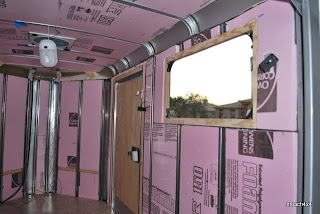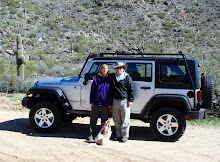I haven't posted for a bit, but I have been doing some work on the trailer between other commitments. (That is making sitting home watching TV sound a lot more important, eh?)
A few days ago, I started finished up most of the wiring, insulation, and the ceiling.
I started by lining the walls and floor with plastic masking drops to avoid cleanup after spraying non-expanding foam. I hate cleaning up and I'm sloppy, so it was worth the hour to do all the masking.
Next, I took a can of DAP window and door sealant and shook the bejeezus out of it for a couple of minutes, then stuck the included soda straw in it and started shooting every little crevice, nook, and cranny in the insulation.
The foam is supposed to only expand 10% so it won't push, bulge or move existing structures. That's why it is recommended for doors and windows. Generally, it didn't move much except when I stuck the straw behind the foam board and shot a lot of foam behind it. I noticed some of the foam board did come out a little. Most of the time I was able to just squirt enough foam until the foam started to ooze out of the crack around the straw. Overall, I was real happy with the way the spray foam filled all the cracks, stabilized the small pieces of foam board, and didn't make much of a mess.
After giving the spray foam some time to cure, I put some aluminum duct tape (3M Shurtape) over all the smaller cracks. It helped stabilize the foam board even more.
Satisfied that the insulation was finally done, I started the ceiling. I used a piece of cardboard and made a template for the nose piece. It had a lot of angle cuts, so it took a while to get a reasonable fit. Once it fit acceptably, I transferred the template to a piece of Luan, cut it out, and installed it.
I was happy with the results, but noticed that a couple of pieces of the insulation had moved enough to make the fit a little tighter than with the cardboard template. I think this was more because the cardboard was more flexible than the Luan, but it worked ok.
My plan to cut the remaining ceiling cover was to use two 27" wide pieces running lengthwise, since the ceiling is 54 inches wide. I ripped two 4x8 panels of Luan down to 27", then measured a cutout for the ceiling fan. When I tested the fit, the 96" length of each panel was about 2 1/4" too long. After cutting off the excess length they fit very well. It was a bit of a battle to get the panel edging on and get the panels in place, but it ended up fine. After getting the ceiling panels on, I mounted the ceiling fan fascia plate after cutting it to the right length. Then I mounted the dome lights to complete all the ceiling installation.

The only interior pieces left to do are the cornice covers between the ceiling and walls. I'm waiting to do that until we pick out the upholstery fabric because I think I'll wrap the covers with light foam and then upholster them to match the bed/sofa cover. I also want to upholster the piece above the back door, because it is a low door, and I don't want to bump my head on the sheet metal plate that the factory installed there. Just before coming in for a late dinner after a satisfying day, I temporarily hooked up all the wiring to the battery. I was able to test the LED dome light, the old dome light (moved to above the desk), the porch light, and the ceiling fan. They all worked great. The only remaining circuits to test will be the LED reading lights and the 12v and 120v outlets that will be mounted in the front cabinet, beneath the counter.
A few weeks ago, just after buying the trailer, I sat down and sketched a design for a bed that would meet my requirements:
1) Able to be removed when I need to use the trailer for cargo hauling.
2) As light as possible
3) As much flexible storage under the bed as possible.
4) If possible, able to be folded up into a sofa for watching movies, eating, or lounging around on rainy days
5) About as big as a full size mattress, with the corner cut back to clear the side door.
Shortly after sketching the design, I bought the lumber to build the bed. Since I don't have my wood shop any more, I had Home Despot use their panel cutter to do most of the cuts. Then, I decided to insulate the trailer and put the windows in first, since I would have to pull the bed out to do that eventually. It was the right choice, but I've been antsy to get the bed design built while doing all the tedius work of insulation and windows, wiring, etc.
Finally, today I started on the bed. The first step was to mount bed rails along each side of the trailer. Here is the finished install of the driver side.
And, here is the curb side rail
The Douglas Fir rails are screwed into the frame of the trailer, in order to be as strong and light as possible. I assembled the bed platform on the garage floor. Because it has to fold up to be a sofa, it has 3 piano hinges in it. Two are on top of the platform, and one is on the bottom.
Sorry, I couldn't resist showing how it folds up for storage. Here it is laid out on the garage floor.
The dimensions of the bed platform are 73 inches long by 57 inches wide. It has 4 pieces that are hinged together. The rear piece is 6 inches by 57 inches with cutouts for the back frame of the trailer. The second piece connects to the back, and is 19 inches by 57 inches. The third piece connects to the second, and is also 19 inches by 57 inches. The fourth piece connects to the third and is 29 inches by 57 inches. It is cut at the front with a 13" by 13" triangle to clear the side door.
When I was getting ready to install it on the bed rails, I stood it up, half folded up, behind the trailer. For a moment, I thought "Maybe if it doesn't work out as a bed, I can use it as a privacy curtain for a shower or porta potty." But then I thought better, and loaded it up into the trailer according to plan
With the bed laid out, there is lots of storage underneath it. I mounted the rails at 17 1/4" above the floor. Just enough clearance for large Rubbermaid totes and coolers to fit under the bed.

The storage under the bed is pretty open.
The platform slides to the back and accordians up to create a sofa seat.
At this point, the seat of the sofa looks quite long, but with 5" cushions on top of it and on the back part, plus throw pillows along the sides and back, I think it will be fine. I took the measurements from my sofa in the living room of my home, so I am hoping it will be as comfy to sit on. The dimensions of the trailers bed/sofa frame are 29 inches deep, 57 inches wide, and the back is 19 inches high. So, with the 5 inch cushion on the back, the seat will be 24 inches deep minus any pillows. And with it folded up, you still have quite a bit of storage, including a place to store the third cushion behind the seat. The third cushion is 25 inches by 57 inches.
In sofa or bed position, the storage will still be easily accessible from the rear door and from the front. I plan to always travel with the bed down. It will keep the center of gravity lower, and not stress out the hinges as much.
In order to keep the plywood platform from sagging down with weight on it, I plan to put a third support system down the middle of the trailer. It will have two pieces. The rear support piece will be stationary, bolted to the floor and the rear piece of the platform. The front support piece will be bolted to and slide with the front plateform piece. I should have the supports built soon.
Stay tuned!
Gil








































